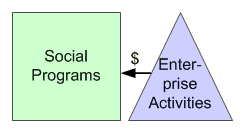External Social Enterprises
External Social Enterprises Social programs are distinct from business activities. Nonprofits create external social enterprises to fund their social services and/or operating costs.
Social programs are distinct from business activities. Nonprofits create external social enterprises to fund their social services and/or operating costs.
The enterprise's activities are "external" from the organization’s operations, but support its social programs through supplementary financing. External social enterprises generally do not benefit from leveraging, cost sharing or program synergies, therefore to serve their purpose, they must be profitable.
External social enterprise may be structured within the parent organization as a profit center, or separately as a nonprofit or for-profit subsidiary. Legal status is often a function of the regulatory environment in which the external social enterprise operates, or a requirement to access capital, (i.e. loans or equity investments). External social enterprises registered as for-profit entities are subject to local tax laws.
The relationship between the business activities and social programs is supportive, providing unrestricted funding to the nonprofit parent organization
External social enterprises are often unrelated to mission; their business activities are not required to advance the organization's mission other than by generating income for the its social programs or overhead.
An external social enterprise generates economic value to support social value creation.
External social enterprises are evident in operational models where:
- economic and social activities are linked via their nonprofit ownership and funding relationship;
- motivation for economic activities is as a funding mechanism for social activities;
- the target population (clients) is a direct beneficiary of income earned from the social enterprise vis-a-vis financing the parent organization, but are infrequently involved in enterprise operations.
The Organizational Support Model often take the form of external social enterprise.
Council of Community Clinics, an example of External Social Enterprise
Council of Community Clinics (CCC) is a San Diego-based nonprofit membership organization comprised of community clinics serving poor, largely Mexican and Central American populations in the region. CCC's mission is to "serve the growing number of uninsured by reducing cost, improving quality of care, and strengthening the capacity of community health centers to improve community health," which it accomplishes through three linked but separate entities: two nonprofits and one for profit subsidiary--an external social enterprise.
CCC's primarily social activities are advocacy, working to change laws to protect at-risk populations and strengthen the health safety net for uninsured and underinsured people. Under the umbrella of CCC is another nonprofit, Community Clinic Health Network (CCHN), which provides technical assistance services to build capacity of community clinics in several areas of healthcare and management. The third structure is a for-profit, Council Connections, a wholly owned for-profit subsidiary of CCC.
Founded in 1996, Council Connections (CC) is a group purchasing business that buys pharmaceuticals, office supplies, medical surgical supplies, and laboratory services in bulk at a volume-based discounted prices, then sells them to community clinics at a slight mark-up, yet substantially cheaper than retail prices. Council Connections business activities are separate from its social programs, and in other than one customer segment, "member" health clinics, there is little overlap with CC's nonprofit parent, Council of Community Clinics. After-tax profit from the group purchasing business provides a significant revenue stream to both nonprofits, CCC and CCHN. The clinics realize substantial savings, which helps to lower their costs, and allocate those savings to their social programs.
Market--In the beginning, the group purchasing business sold its products exclusively to CCC’s members, a relatively small market of a few hundred community clinics in the state of California. As a social enterprise, Council Connections soon realized that it could better serve its customers and increase its profitability by reaching untapped markets. By 2001, of its 691 customers in the State of California, 364 (52.7%) were member community health clinics, and 327 (47.3%) were nonmembers clinics. Entering the nonmember market segment made it possible for CC’s service to benefit more community clinics. The plan is to expand Council Connections' business nationally via the Internet to generate more dollars for clinical services to the uninsured and underinsured.
Financial viability--Income has climbed steadily since Council Connections' first year. In 2001 Council Connections had total sales of $14,370,000, and after tax revenues of $951,566, to reinvest in business growth and social investments in its nonprofit parent. This figure is up 54% from 1997 sales of $6,622,183, and revenue of $531,489 for the same year. Council Connections new online sales business expects revenues to reach $2,500,000 within 5 years.
Social Impact--Council Connections contributed $332,935 in 2001 to CCC and CCHN’s social programs, which translated into subsidies of $207,935 to member clinics, enabling community health clinics to render more discounted and free services to the uninsured and underinsured poor. Seventy-five thousand dollars was used to offset the cost of shared services and $50,000 for technical assistance. In the same year, CC’s member clinics saved a total of $7,650,803 on medical and pharmaceutical supplies and services, allowing clinics to spend those savings on social interests.
Council Connections' primary purpose is to provide funding to its nonprofit parent organization CCC, and nonprofit subsidiary, CCHN. Council Connections secondary purpose is to provide valuable service at reduced costs to its customers, community clinics. Council Connections is an unusual example of a mission-related external social enterprise, it mission states: "support the commitment and mission of community health centers to improve community health by delivering high quality, cost effective patient care through the provision of technical assistance to improve purchasing and inventory systems; reduce costs of products and services; move towards automation, best practices and standardization."